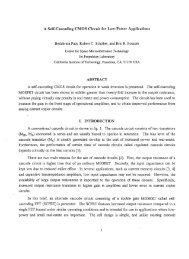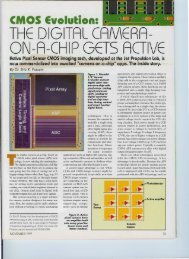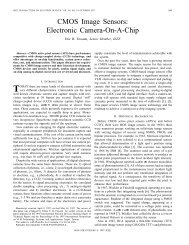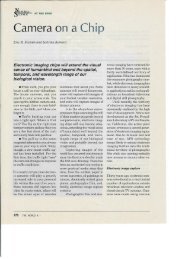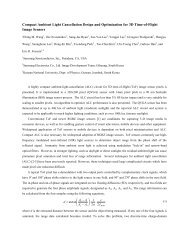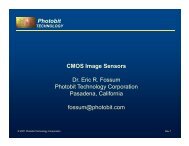Infrared readout electronics for space science sensors - Eric Fossum
Infrared readout electronics for space science sensors - Eric Fossum
Infrared readout electronics for space science sensors - Eric Fossum
You also want an ePaper? Increase the reach of your titles
YUMPU automatically turns print PDFs into web optimized ePapers that Google loves.
Commercially available GaAs MESFETs have been extensively measured by Kirschrnan [39,40]. Noise levels ofapproximately 50 nV/Hz"2 at 10 Hz <strong>for</strong> 4 K operation were reported. A 2x64 multiplexer was demonstrated by Rockwell[41J. Measured noise at 78 K was approximately 1 tV/Hz2 at 10 Hz. The major problems facing MIESFET <strong>readout</strong><strong>electronics</strong> are gate leakage current and power dissipation in integrated circuits. Unlike a silicon device that has a largeoxide barrier to gate leakage, GaAs MESFETs have a 0.8 eV barrier that permits some measurable currents even atcryogenic temperatures. However, improvement of the leakage current to levels acceptable <strong>for</strong> practical application isconsidered feasible. The lack of a true complementary circuit technology makes power levels in the <strong>readout</strong> circuits anissue <strong>for</strong> scientific applications though complementary enhancement/depletion mode MIESFET circuits are being explored<strong>for</strong> <strong>readout</strong> application [42].GaAs nJFETs were fabricated by Aerojet and measured by Ames [43]. These devices were reported to have a veiy lownoise level of 10 nV/Hz"2 at 10 Hz <strong>for</strong> 4 K operation, comparable to silicon WETs at 55K. While potentially anexcellent front end <strong>for</strong> silicon <strong>readout</strong> <strong>electronics</strong> or GaAs CHFET <strong>electronics</strong> (see below), GaAs n-JFET technology byitself suffers the same high power dissipation problem as GaAs MESFETs. However, the gate leakage current of a JIFETtechnology is expected to he low enough to be of practical use in low background JR applications since the gate barrier isgreater than I eV,GaAs complementary heterostructure FET (CHFET) technology is a demonstrated LSI circuit technology <strong>for</strong> high speeddigital circuits at 77 K and above [44]. JPL has explored this technology <strong>for</strong> possible application to scientific JR FPA<strong>readout</strong> [45,46]. The CHFET technology has noise levels of the order of 2 tV/Hz"2 at 10 Hz <strong>for</strong> 4 K operation --a valuetoo large to be of practical use in low background applications. The CHFET technology also has a gate leakage currentthat is considered still too high fOr use in the same application.5OtherTecjQgjesOther technologies that have been explored <strong>for</strong> <strong>readout</strong> of JR FPAs include silicon bipolar devices [47], InP HBT devices[48] and superconducting circuits [49,50]. The bipolar devices have low input impedance and higher noise. Thesuperconducting circuits are of interest to low temperature, low background applications due to their low power and noise,and intrinsic compatibility with low temperature JR detector operation. However, the extremely low input impedance(intrinsic to superconducting circuits) makes it difficult to interface these circuits with semiconductor detectors.6. FUTURE DIRECTIONSScientific JR EPA <strong>readout</strong> <strong>electronics</strong> will continue to benefit from continued DoD investment in JR FPAs. However, thetechnology is rapidly reaching a branch point. DoD JR FPAs are clustered in the atmospheric window wavelengths(3-5 .tm, 8-12 sm), and are aimed at convenient operating conditions. These include 77-80 K operating temperature andNTSC video <strong>for</strong>mats such as 640x480 <strong>for</strong> tactical applications. Some work continues in the longer wavelength, 20 KLWJR detector area <strong>for</strong> <strong>space</strong> applications. However, scientific <strong>sensors</strong> require increasingly lower noise floors, with subelectronread noise desired by the turn of the century. The need <strong>for</strong> large <strong>for</strong>mats with long integration times increases thedisparity between DoD-funded development and scientific requirements. To some extent, DoD is becoming moreinterested in infrared spectroscopy as a surveillance and reconnaissance technique, so that some leverage might beexpected in the future <strong>for</strong> the development of scientific infrared imaging spectroscopy instruments. These will be lownoise, high data bandwidth instruments.NASA's current needs in sensor <strong>electronics</strong> were identified during the Astrotech '2 1 Workshop series [5 1] . These needsinclude sub-electron read noise, cryogenic 4 K <strong>readout</strong> <strong>electronics</strong> <strong>for</strong> SIRTF, low noise discrete transistors <strong>for</strong> 80K,advanced packaging techniques (e.g. thermal compartmentalization), advanced interfaces such as analog-to-digitalconverters and optical links, and advanced architectures such as event-driven <strong>readout</strong>. Some technical areas that areemerging as future directions are described briefly below.280 / SPIE Vol. 2020 infrared Technology XIX (1993)



